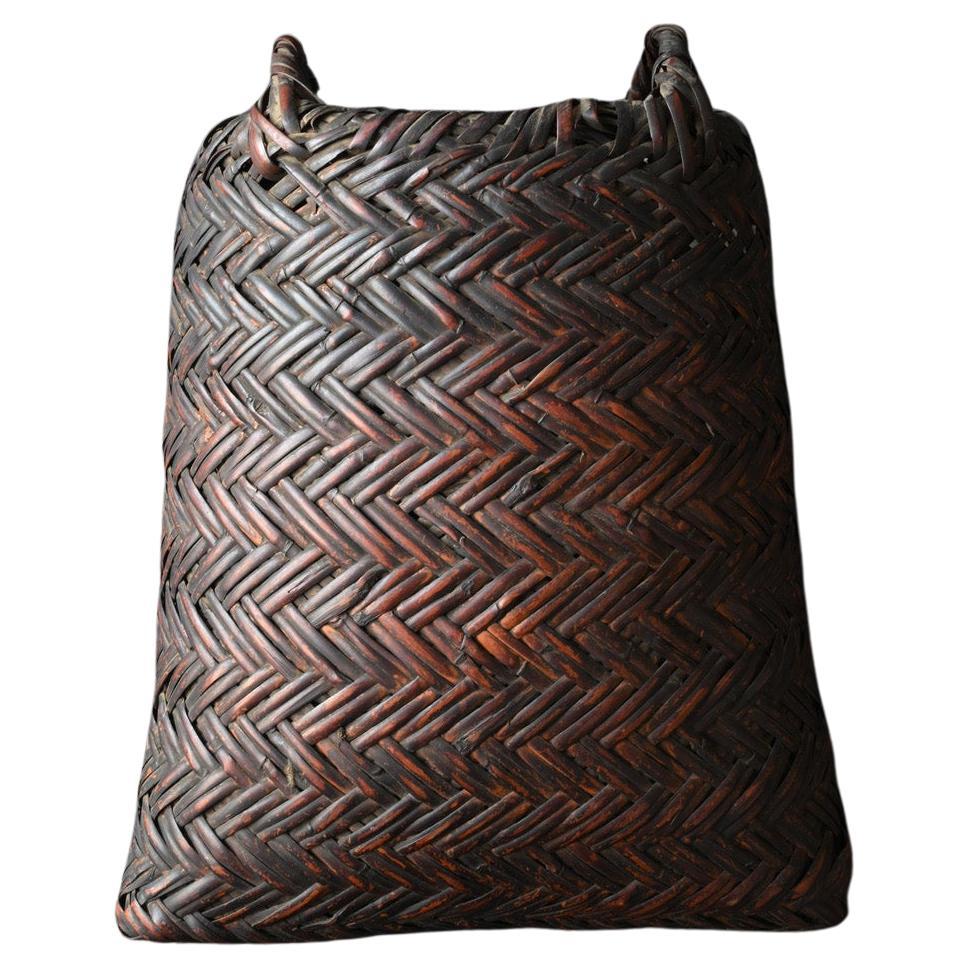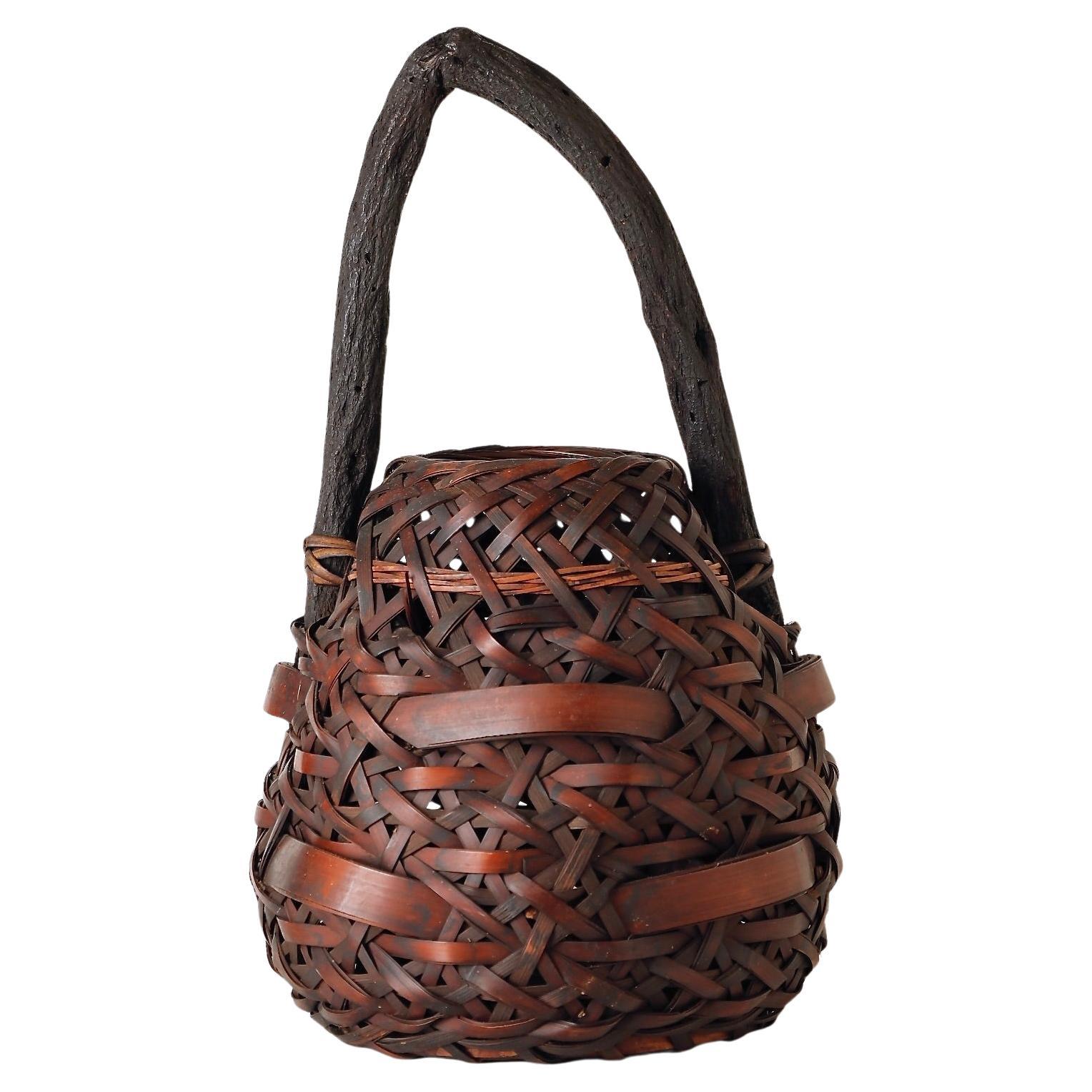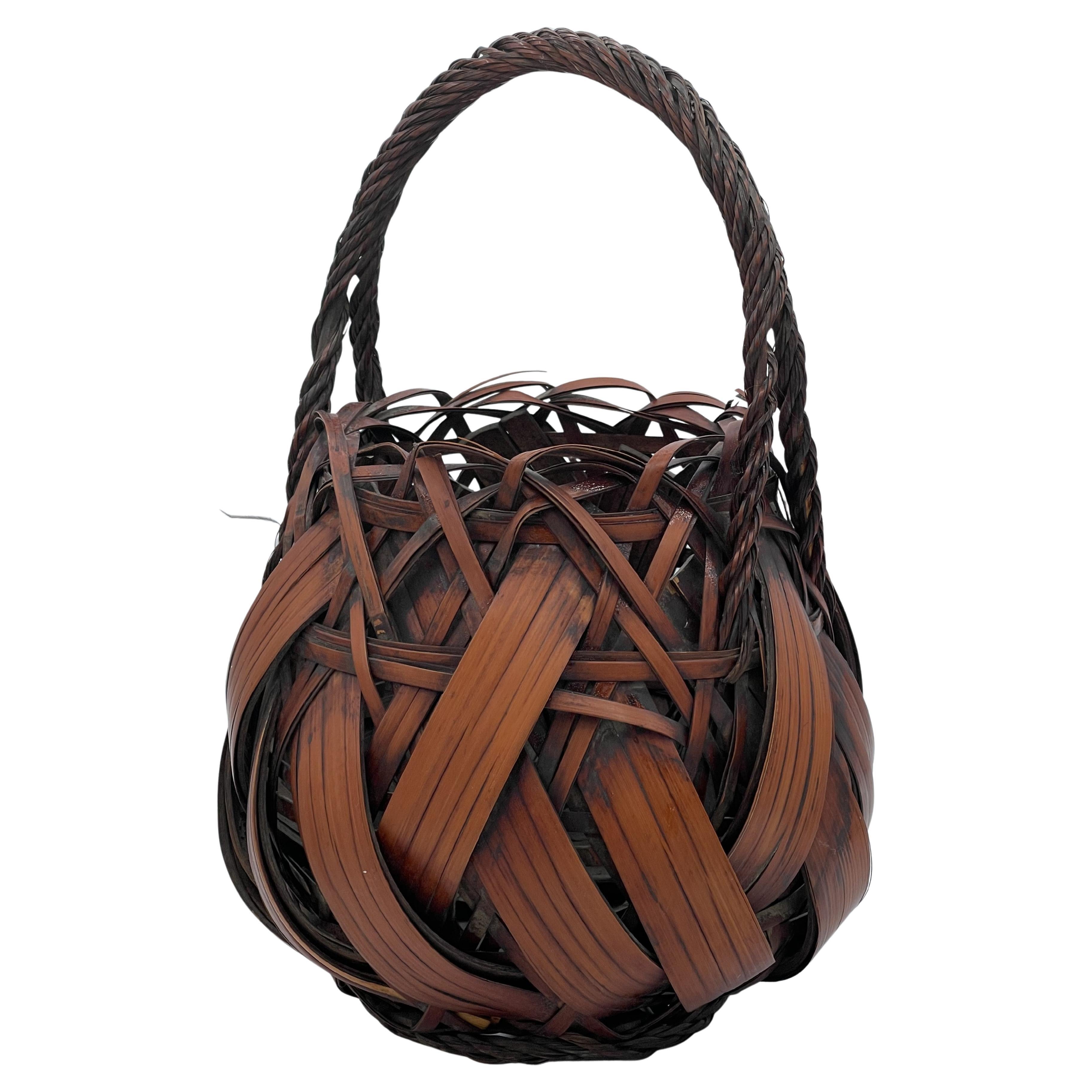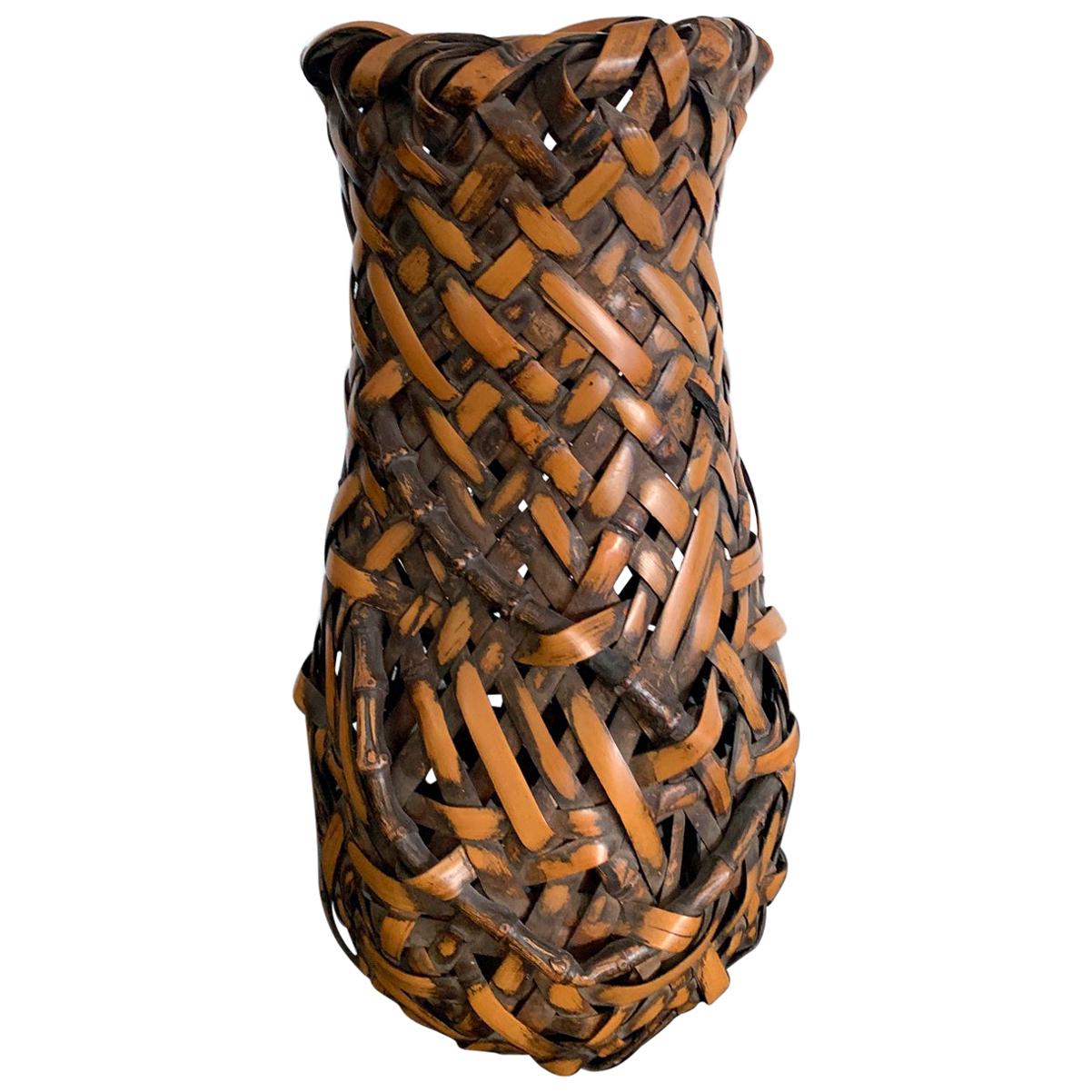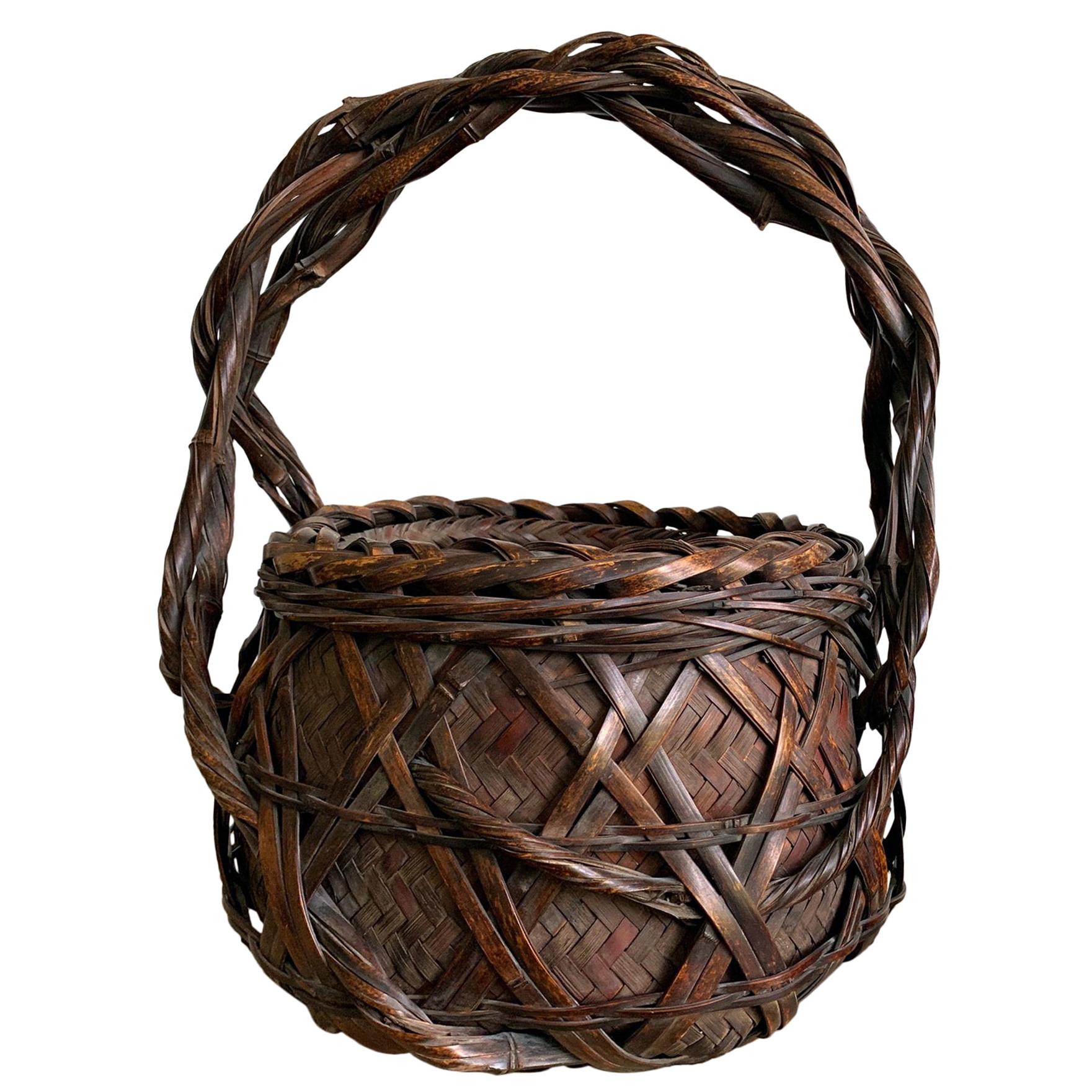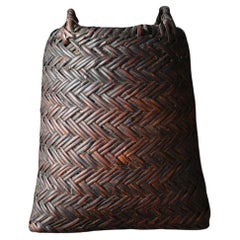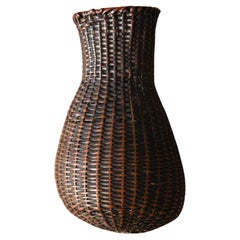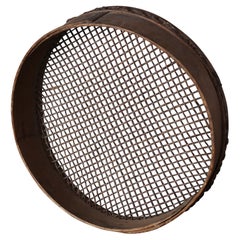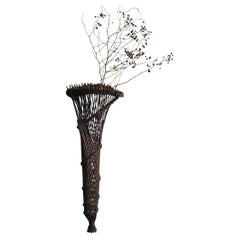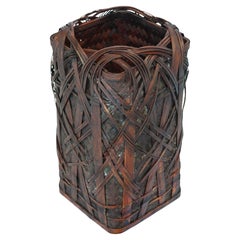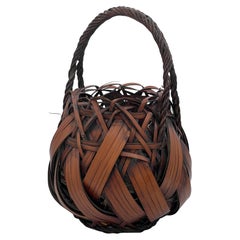Items Similar to Antique Japanese woven wall hanging basket/20th century/Wabi-sabi vase
Want more images or videos?
Request additional images or videos from the seller
1 of 20
Antique Japanese woven wall hanging basket/20th century/Wabi-sabi vase
$1,000
£759.32
€868.34
CA$1,397.15
A$1,553.93
CHF 811.41
MX$18,909.68
NOK 10,363
SEK 9,718.66
DKK 6,480.78
Shipping
Retrieving quote...The 1stDibs Promise:
Authenticity Guarantee,
Money-Back Guarantee,
24-Hour Cancellation
About the Item
This is a rustic woven basket made of walnut bark, made in Japan around the 20th century.
In Japan, tools made of natural materials have been used since ancient times as baskets for carrying harvested goods when farming, gathering wild vegetables, or picking mushrooms. It is not certain whether this product was used for agricultural purposes, but it is possible that it was made with the intention of being used as a flower vase from the beginning.
Walnut bark, which is strong and rich in flavor, is used as a material, along with bamboo, wild grapes, and matatabi. The elasticity of the firm, dried bark is utilized to create boldly woven thick strips of bark. The warmth and natural roughness of the handwork stand out in this item. The weave of this item is coarse and has a snorting distortion.
The rustic yet present form is the very embodiment of the spirit of wabi-sabi. When hung on a wall, the wide-open mouth creates a sense of three-dimensionality in the space and enhances the simplicity of the wall. The natural sense of rhythm created by the not-too-formal shape blends well with both modern and traditional Japanese spaces.
The item is in good condition overall, with no major damage, although there are some fraying and minor blemishes. Please note that the flowers and bamboo tube shown in the photos are not included. When arranging flowers, you can easily display them by inserting a cut plastic bottle or other container inside.
There are various types of baskets in Japan, but these baskets have a rugged and natural beauty that is different from fine bamboo work.
The unrefined feel of the material and the unique flavor of the bark, which has faded over time, give these baskets a unique charm that cannot be found anywhere else.
Its relatively large size (W34 x D27 x H50 cm) makes it perfect for accenting a space. Weighing only about 0.7 kg, it can be easily enjoyed as a wall-hanging interior. This product does not stand on its own, so please be sure to hang it on the wall.
The crisp and supple feel of the dried bark is also something to be savored.
Weight: 0.7kg
[We are a specialized team dealing in antiques and vintage items, comprised of stores based on three distinct brands. While focusing on Japanese items, we also offer a carefully curated selection of attractive goods from around the world—each evoking the culture and history of its country of origin.
Unlike the traditional Japanese antique furniture and art that have been appreciated overseas until now, we shine a light on the tools and furniture that were used for many years in ordinary Japanese homes and farmhouses. These objects have gained a unique charm over time, their beauty deepened by the history accumulated through daily life. In today’s world, however, many of these precious items are discarded during home demolitions. We are committed to reassessing their value and passing them on to future generations.
Drawing from our extensive experience—having seen tens of thousands of items through direct purchases, markets, and auction houses—we carefully select and present only the most captivating pieces. This is something made possible only through the years of knowledge and expertise we have cultivated.
Rather than focusing on the widely known facets of Japanese art and culture, we highlight the subtle beauty born from the everyday life of common people. It is this rediscovered beauty, steeped in history, that we strive to share with the world.]
About the Seller
5.0
Gold Seller
Premium sellers maintaining a 4.3+ rating and 24-hour response times
Established in 2015
1stDibs seller since 2020
1,602 sales on 1stDibs
Typical response time: 5 hours
- ShippingRetrieving quote...Shipping from: senzoku, Japan
- Return Policy
Authenticity Guarantee
In the unlikely event there’s an issue with an item’s authenticity, contact us within 1 year for a full refund. DetailsMoney-Back Guarantee
If your item is not as described, is damaged in transit, or does not arrive, contact us within 7 days for a full refund. Details24-Hour Cancellation
You have a 24-hour grace period in which to reconsider your purchase, with no questions asked.Vetted Professional Sellers
Our world-class sellers must adhere to strict standards for service and quality, maintaining the integrity of our listings.Price-Match Guarantee
If you find that a seller listed the same item for a lower price elsewhere, we’ll match it.Trusted Global Delivery
Our best-in-class carrier network provides specialized shipping options worldwide, including custom delivery.More From This Seller
View AllJapanese antique bamboo woven basket/wall hanging vase/1868-1920/Mingei
Located in Sammu-shi, Chiba
This is a woven bamboo basket made in Japan from the Meiji to Taisho periods (1868-1920).
I don't know if the baskets actually used by farmers were repurposed as flower vases, or if ...
Category
Early 20th Century Japanese Meiji Decorative Art
Materials
Bamboo
Japanese antique wall hanging bamboo vase/1868-1920/Wabisabi object
Located in Sammu-shi, Chiba
This is an old bamboo vase made from the Meiji period to the Taisho period (1868-1920).
It is made in the shape of a fish cage using thin bamboo strips.
In Japan, fish caught in rive...
Category
Antique 19th Century Japanese Meiji Decorative Art
Materials
Bamboo
Basket Woven from Japanese Bamboo / Wabi-Sabi Bamboo Object
Located in Sammu-shi, Chiba
It is an old Japanese basket.
It seems that it was used to dry something.
A charming object with a wabisabi atmosphere.
The shadows are very nic...
Category
Antique Late 19th Century Japanese Meiji Decorative Baskets
Materials
Bamboo
Antique wall-hanging vase made from Japanese bamboo/River fishing equipment
Located in Sammu-shi, Chiba
This is a traditional Japanese fishing implement called an "uke," crafted from bamboo during the Meiji to early Showa period. It was placed in rivers to trap eels and loaches, which,...
Category
Antique Late 19th Century Japanese Taisho Decorative Art
Materials
Bamboo
Bamboo Flower Vase by Suigetsu Buseki
Located in Sammu-shi, Chiba
Bamboo Flower vase by Suigetsu Buseki .
Suigetsu Buseki (1930–2013)
He is the second generation of "Bamboo Craft Midoriya". He studied under Koka...
Category
Vintage 1950s Japanese Japonisme Sculptures and Carvings
Materials
Bamboo
Bamboo Flower Vase by Chikuyu Uematsu
By Uematsu Chikuyu
Located in Sammu-shi, Chiba
Bamboo vase by Chikuyu Uematsu.
With original box.
Chikuyu Uematsu (1947-)
He was born in Tokyo. He graduated from Beppu Higher Vocational Training School in 1975. From the same yea...
Category
1990s Japanese Japonisme Sculptures and Carvings
Materials
Bamboo
You May Also Like
Oversized Handmade Japanese Ikebana Floor Basket
Located in Malibu, CA
Vintage Japanese Ikebana Floor Basket. The basket features a unique design with a woven background & high-quality bamboo with freestyle form embellishing the underneath basket.
Suita...
Category
20th Century Japanese Folk Art Decorative Baskets
Materials
Bamboo, Reed
$236 Sale Price
20% Off
Superb Japanese Ikebana Bamboo Basket, 20th Century
Located in Fukuoka, JP
A beautiful example of Japanese craftsmanship, this Ikebana bamboo basket dates to the 20th century and showcases a finely woven structure with graceful proportions and elegant verti...
Category
20th Century Japanese Showa Decorative Baskets
Materials
Bamboo
Japanese Late Meiji Period (1868-1912) Woven Bamboo Basket, Early 20th Century
Located in New York, NY
Japanese Late Meiji Period (1868-1912) Woven Bamboo Basket, Early 20th Century
DIMENSIONS
Height: 14 inches
Diameter: 8.5 inches
ABOUT
A finely hand-woven Japanese bamboo basket fr...
Category
Early 20th Century Japanese Japonisme Decorative Baskets
Materials
Bamboo
Japanese Hanging Bamboo Ikebana Basket Signed
Located in Atlanta, GA
A Japanese bamboo Ikebana hanging basket circa 1920s-1940s, made with "sooted" bamboo (susutake in Japanese). This bamboo material was collected from traditional thatched-roof houses...
Category
Early 20th Century Japanese Japonisme Sculptures and Carvings
Materials
Bamboo
Japanese Wagumi Handled Bamboo Basket Ikebana
Located in Atlanta, GA
Bold, rustic and with an earthy free spirit, this wagumi style flower basket with twisted handle (ikebana) was designed and woven to evoke a sense of serenity and humbleness during t...
Category
Vintage 1920s Japanese Japonisme Sculptures and Carvings
Materials
Bamboo
Japanese Antiques Kosuge Kogetsu Bamboo Woven Flower Basket
Located in Niiza, JP
φ125/180 (W/W including ears) x 350 (H) mm,
box size: 170 (W) x 180 (H) x 500 (D) [mm], 1.5 kg
In good condition with almost no signs of use
The bamboo is split into small pieces t...
Category
20th Century Japanese Antiquities
Materials
Bamboo
More Ways To Browse
Japanese Weaving
Japanese Rustic
Japanese Containers
Japanese Wall Hanging
Japanese Bamboo Stand
Japanese Wall Hanging Vase
Vintage Wall Kitchen Cabinet
Antique Brass Escutcheon Plate
Antique Etched Glass Panel
Antique Polishing Machine
Antique Tea Chest
Antique Tea Chests
Antique Wood India Cabinet
Antique Wooden Bottle
Arte Ceramica
Blue Cobalt Glass Dish
Blue Porcelain Mantel Clock
Brass Cellarette
